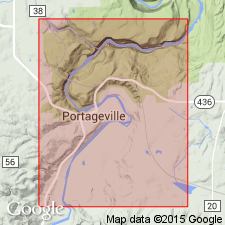
- Usage in publication:
-
- Portage sandstones
- Modifications:
-
- Original reference
- Dominant lithology:
-
- Sandstone
- Shale
- AAPG geologic province:
-
- Appalachian basin
Summary:
Pg. 226, 228-229, 248. Portage sandstones. The thick-bedded sandstones at Portage, which form terminal rocks of Portage group. Well exposed in deep gorge below Portageville [Wyoming County, New York]. Upper part consists of thick-bedded sandstone with little shale; while below the sandy layers become thinner, with more frequent alternations of shale. The thick-bedded character of the sandstones and presence of fucoids passing vertically through the strata induced separation from the rocks below, where the characteristic species of same genus lies horizontally upon surface of the strata. Rests on Gardeau shale and flagstones and is overlain by Chemung group. [Age is Late Devonian.]
[GNC remark (ca. 1936, US geologic names lexicon, USGS Bull. 896, p. 1705): In some reports this sandstone has been included in Chemung group. See further explanation under Portage group.]
Source: US geologic names lexicon (USGS Bull. 896, p. 1704-1705).

- Usage in publication:
-
- Portage sandstone†
- Modifications:
-
- Abandoned
- AAPG geologic province:
-
- Appalachian basin
Summary:
†Portage sandstone abandoned. In 1908 J.M. Clarke and D.D. Luther replaced this name with Nunda sandstone, which they included in Portage formation. C.A. Hartnagel (1912 Hdb.) and G.H. Chadwick, 1923 (GSA Bull., v. 34, p. 69) also included this sandstone in the Portage. Chadwick later (see 1935 entry under Portage group) recommended abandonment of Portage group and limitation of Portage to this sandstone.
Source: US geologic names lexicon (USGS Bull. 896, p. 1704-1705).
For more information, please contact Nancy Stamm, Geologic Names Committee Secretary.
Asterisk (*) indicates published by U.S. Geological Survey authors.
"No current usage" (†) implies that a name has been abandoned or has fallen into disuse. Former usage and, if known, replacement name given in parentheses ( ).
Slash (/) indicates name conflicts with nomenclatural guidelines (CSN, 1933; ACSN, 1961, 1970; NACSN, 1983, 2005, 2021). May be explained within brackets ([ ]).

